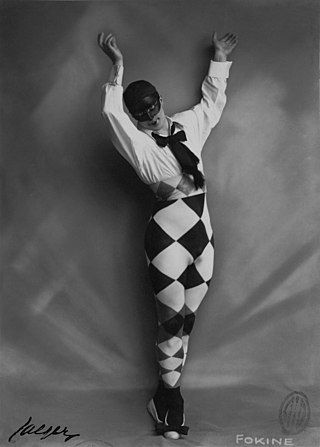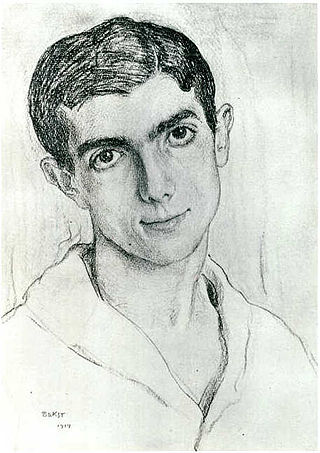
Sergei Pavlovich Diaghilev, also known as Serge Diaghilev, was a Russian art critic, patron, ballet impresario and founder of the Ballets Russes, from which many famous dancers and choreographers would arise.

Vaslav or Vatslav Nijinsky was a Russian ballet dancer and choreographer of Polish ancestry. He is regarded as the greatest male dancer of the early 20th century.

Michael Fokine was a Russian choreographer and dancer.

Bronislava Nijinska was a Russian ballet dancer of Polish origin, and an innovative choreographer. She came of age in a family of traveling, professional dancers.

The Afternoon of a Faun is a ballet choreographed by Vaslav Nijinsky for the Ballets Russes, and was first performed in the Théâtre du Châtelet in Paris on 29 May 1912. Nijinsky danced the main part himself. The ballet is set to Claude Debussy's symphonic poem Prélude à l'après-midi d'un faune. Both the music and the ballet were inspired by the poem L'Après-midi d'un faune by Stéphane Mallarmé. The costumes, sets and programme illustrations were designed by the painter Léon Bakst.

Les Sylphides is a short, non-narrative ballet blanc to piano music by Frédéric Chopin, selected and orchestrated by Alexander Glazunov.

Léon Bakst, born Leyb-Khaim Izrailevich Rosenberg, was a Russian painter and scene and costume designer of Jewish origin. He was a member of the Sergei Diaghilev circle and the Ballets Russes, for which he designed exotic, richly coloured sets and costumes. He designed the décor for such productions as Carnaval (1910), Spectre de la rose (1911), Daphnis and Chloe (1912), The Sleeping Princess (1921) and others.

Leonid Fyodorovich Myasin, better known in the West by the French transliteration as Léonide Massine, was a Russian choreographer and ballet dancer. Massine created the world's first symphonic ballet, Les Présages, and many others in the same vein. Besides his "symphonic ballets," Massine choreographed many other popular works during his long career, some of which were serious and dramatic, and others lighthearted and romantic. He created some of his most famous roles in his own comic works, among them the Can-Can Dancer in La Boutique fantasque (1919), the Hussar in Le Beau Danube (1924), and, perhaps best known of all, the Peruvian in Gaîté Parisienne (1938). Today his oeuvre is represented by his son Lorca Massine, who stages his works around the world.

Ida Lvovna Rubinstein was a dancer, actress, art patron and Belle Époque figure from the Russian Empire. She performed with Diaghilev's Ballets Russes from 1909 to 1911 and later formed her own company. Boléro by Ravel (1928) was among her commissions.

Scheherazade, also commonly Sheherazade, Op. 35, is a symphonic suite composed by Nikolai Rimsky-Korsakov in 1888 and based on One Thousand and One Nights.

The Ballets Russes was an itinerant ballet company begun in Paris that performed between 1909 and 1929 throughout Europe and on tours to North and South America. The company never performed in Russia, where the Revolution disrupted society. After its initial Paris season, the company had no formal ties there.

Carnaval is a ballet based on the music of Robert Schumann's piano suite Carnaval, Op. 9, as orchestrated by Alexander Glazunov, Nikolai Rimsky-Korsakov, Anatoly Lyadov and Alexander Tcherepnin. It was choreographed by Michel Fokine to his own libretto, with costumes designed by Léon Bakst, and premiered in Pavlovsk on 5 March 1910.

Le Spectre de la rose is a short ballet about a young girl who dreams of dancing with the spirit of a souvenir rose from her first ball. The ballet was written by Jean-Louis Vaudoyer who based the story on a verse by Théophile Gautier and used the music of Carl Maria von Weber's piano piece Aufforderung zum Tanz as orchestrated by Hector Berlioz.

Maria Nikolaevna Kuznetsova, also known as Maria Kuznetsova-Benois, was a 20th century Russian opera singer and dancer.

The company Ballets Russes de Monte-Carlo was formed in 1932 after the death of Sergei Diaghilev and the demise of Ballets Russes. Its director was Wassily de Basil, and its artistic director was René Blum. They fell out in 1936 and the company split. The part which de Basil retained went through two name changes before becoming the Original Ballet Russe. Blum founded Les Ballets de Monte Carlo, which changed its name to Ballet Russe de Monte Carlo when Léonide Massine became artistic director in 1938. It operated under this name until it disbanded some 20 years later.

Nijinsky is a 1980 American biographical film directed by Herbert Ross. Hugh Wheeler wrote a screenplay that explores the later life and career of Vaslav Nijinsky; it was based largely on the premier danseur's personal diaries, and her 1934 biography of Nijinsky, largely ghostwritten by Lincoln Kirstein, who later co-founded the New York City Ballet.
The Original Ballet Russe was a ballet company established in 1931 by René Blum and Colonel Wassily de Basil as a successor to the Ballets Russes, founded in 1909 by Sergei Diaghilev. The company assumed the new name Original Ballet Russe after a split between de Basil and Blum. De Basil led the renamed company, while Blum and others founded a new company under the name Ballet Russe de Monte-Carlo. It was a large scale professional ballet company which toured extensively in Europe, Australia and New Zealand, the United States, and Central and South America. It closed down operations in 1947.

Le Pavillon d'Armide is a ballet in one act and three scenes choreographed by Michel Fokine with music by Nikolai Tcherepnin to a libretto by Alexandre Benois. It was inspired by the novella Omphale by Théophile Gautier.

Le Dieu bleu is a ballet in one act choreographed by Michel Fokine to music by Reynaldo Hahn, set to a libretto by Jean Cocteau and Federico de Madrazo y Ochoa. Léon Bakst designed the sets and costumes.

Cléopâtre is a ballet in one act with choreography by Mikhail Fokine and music by Anton Arensky, Alexander Taneyev, Nikolai Rimsky-Korsakov, Mikhail Glinka, Alexander Glazunov, Modeste Mussorgsky, and Nikolai Tcherepnin. The scenery and costumes were created by Léon Bakst. The first production opened at Théâtre du Châtelet in Paris on June 2, 1909.




















